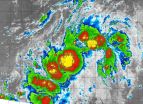NASA-NOAA's Suomi NPP satellite sees Tropical Depression 14E disorganized
2015-09-01
(Press-News.org) Tropical Depression 14E was born in the Eastern Pacific Ocean early on September 1 when NASA-NOAA's Suomi NPP satellite passed overhead and looked at it in infrared light.
Infrared light shows temperature, which is helpful in determining cloud top temperatures of the thunderstorms that make up a tropical cyclone line Tropical Depression 14E (TD 14E). The colder the storm, the higher they stretch into the troposphere (lowest layer of the atmosphere) and the stronger the storms tend to be.
On September 1 at 0900 UTC (5 a.m. EDT), NASA-NOAA's Suomi NPP satellite passed over TD 14E and the Visible Infrared Imaging Radiometer Suite (VIIRS) instrument aboard looked at the developing depression in infrared light. The VIIRS imagery showed fragmented thunderstorms around the center of circulation that appears to be stretched from southwest to northeast. The National Hurricane Center noted that the cloud pattern continues to be elongated and the convection (rising air that forms thunderstorms) is not very well organized at this time.
On September 1 at 11 a.m. EDT (1500 UTC), the center of TD 14E was located near latitude 13.0 North and longitude 113.6 West. That's about 725 miles (1,165 km) south-southwest of the southern tip of Baja California, Mexico. Maximum sustained winds remain near 35 mph (55 kph) and the National Hurricane Center said the depression is forecast to become a tropical storm later on September 1 or 2.
TD 14E's estimated minimum central pressure is 1006 millibars. The depression is moving toward the north-northwest near 8 mph (13 kph), and this general motion with a gradual turn to the north is anticipated during the next 2 days.
NHC Forecaster Avila said that TD 14E has a chance to strengthen a little bit during the next day or two, before stronger southerly upper-level winds ahead of a trough (elongated area of low pressure) begin to impact the cyclone.
INFORMATION:
[Attachments] See images for this press release:

ELSE PRESS RELEASES FROM THIS DATE:
2015-09-01
Hurricane Ignacio is staying far enough away from the Hawaiian Islands to not bring heavy rainfall or gusty winds, but is still causing rough surf. Infrared satellite data on September 1 shows that wind shear is adversely affecting the storm and weakening it.
The Atmospheric Infrared Sounder or AIRS instrument that flies aboard NASA's Aqua satellite gathers infrared data that reveals temperatures. When NASA's Aqua satellite passed over Ignacio on September 1 at 11:41 UTC (7:41 a.m. EDT), the AIRS data and showed some high, cold, strong thunderstorms surrounded the center ...
2015-09-01
EUGENE, Ore. - Sept. 1, 2015 - The University of Oregon's Kelly Sutherland has seen the future of under-sea exploration by studying the swimming prowess of tiny jellyfish gathered from Puget Sound off Washington's San Juan Island.
In a paper with four colleagues in the Sept. 2 issue of the journal Nature Communications, Sutherland details how a tiny type of jellyfish - colonial siphonophores - swim rapidly by coordinating multiple water-shooting jets from separate but genetically identical units that make up the animal.
Information on the biomechanics of a living organism ...
2015-09-01
WOODS HOLE, MASS.--Marine animals that swim by jet propulsion, such as squid and jellyfish, are not uncommon. But it's rare to find a colony of animals that coordinates multiple jets for whole-group locomotion. This week in Nature Communications, scientists report on a colonial jellyfish-like species, Nanomia bijuga, that uses a sophisticated, multi-jet propulsion system based on an elegant division of labor among young and old members of the colony. This locomotive solution, the team suggests, could illuminate the design of underwater distributed-propulsion vehicles.
"This ...
2015-09-01
Here's another discovery to bolster the case for medical marijuana: New research in mice suggests that THC, the active ingredient in marijuana, may delay the rejection of incompatible organs. Although more research is necessary to determine if there are benefits to humans, this suggests that THC, or a derivative, might prove to be a useful antirejection therapy, particularly in situations where transplanted organs may not be a perfect match. These findings were published in the September 2015 issue of The Journal of Leukocyte Biology.
"We are excited to demonstrate for ...
2015-09-01
COLUMBIA, Mo. - Forgiveness is a complex process, one often fraught with difficulty and angst. Now, researchers in the University of Missouri College of Human Environmental Sciences studied how different facets of forgiveness affected aging adults' feelings of depression. The researchers found older women who forgave others were less likely to report depressive symptoms regardless of whether they felt unforgiven by others. Older men, however, reported the highest levels of depression when they both forgave others and felt unforgiven by others. The researchers say their ...
2015-09-01
Police officers face an elevated risk of being injured in a collision when they are sitting in a stationary car as compared to low-speed driving, as well as when they are responding to an emergency call with their siren blaring as compared to routine patrol, according to a new RAND Corporation study.
In addition, officers face a higher risk of being injured in a crash when they are riding a motorcycle compared to a driving a car, driving solo compared to having a second officer in the car, or not wearing a seatbelt compared to wearing a seatbelt.
The findings provide ...
2015-09-01
With a name like "Alcoholic Liver Disease," you may not think about vitamin A as being part of the problem. That's exactly what scientists have shown, however, in a new research report appearing in the September 2015 issue of The FASEB Journal. In particular, they found that chronic alcohol consumption has a dramatic effect on the way the body handles vitamin A. Long-term drinking lowers vitamin A levels in the liver, which is the main site of alcohol breakdown and vitamin A storage, while raising vitamin A levels in many other tissues. This opens the doors for novel treatments ...
2015-09-01
The study, published today at Nature Methods (the most prestigious journal for the presentation of results in methods development), proposes the use of two plant protein epitopes, named inntags, as the most innocuous and stable tagging tools in the study of physical and functional interactions of proteins.
Proteins and peptides of various sizes and shapes have been used since the early 80s to tag proteins with many different purposes, ranging from affinity purification to fluorescence-based microscopic detection in whole organisms. However, tagging strategies used nowadays ...
2015-09-01
Imagine being in a car with the gas pedal stuck to the floor, heading toward a cliff's edge. Metaphorically speaking, that's what climate change will do to the key group of ocean bacteria known as Trichodesmium, scientists have discovered.
Trichodesmium (called "Tricho" for short by researchers) is one of the few organisms in the ocean that can "fix" atmospheric nitrogen gas, making it available to other organisms. It is crucial because all life -- from algae to whales -- needs nitrogen to grow.
A new study from USC and the Massachusetts-based Woods Hole Oceanographic ...
2015-09-01
If you have diabetes and cancer, here's some hope. In a new research report appearing in the September 2015 issue of The FASEB Journal, scientists reveal a newly discovered tissue- and organ-specific mechanism that regulates blood vessel growth, and when inhibited reduced the growth of tumors in diabetic mice. In addition to the treatment of the diabetes-related cancers, the approach may be also used to treat other diabetic complications that are associated with the increased blood vessel growth, like retinopathy or nephropathy for example.
"Complications of diabetes ...
LAST 30 PRESS RELEASES:
[Press-News.org] NASA-NOAA's Suomi NPP satellite sees Tropical Depression 14E disorganized



